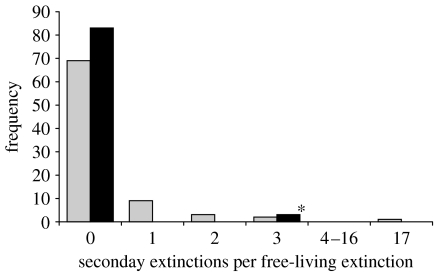Figure 2.
The distribution of secondary extinctions for predators (black bars) and parasites (grey bars) resulting from the primary extinction of each free-living species in the food web. Usually, free-living species were not the sole resource for a parasite or predator, so a few secondary extinctions resulted. The asterisk indicates three secondary extinctions of filter feeders following the extinction of phytoplankton. Because it is unlikely that the entire phytoplankton community would go extinct, these secondary extinctions seem unlikely. The distribution of secondary extinctions had a long right tail, indicating that the extinction of some hosts led to the extinction of one or more parasite species. The extinction of the snail C. californica led to the extinction of 17 trematode species.

